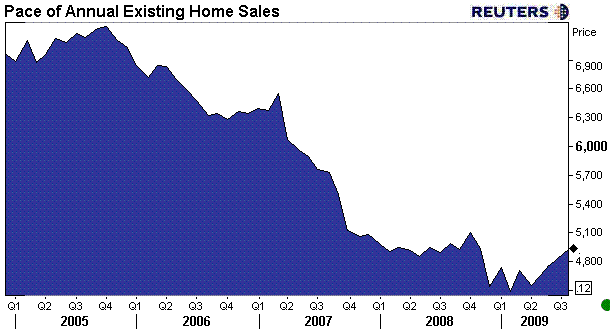First-time homebuyers and the sales of distressed properties helped drive the pace of Existing Home Sales up for the third consecutive month in June. Sales advanced 3.6% in the month, in line with estimates, to an annual rate of 4.89 million units.
“The increase in existing-home sales occurred in all major regions of the country,” said Lawrence Yun, chief economist at the National Association of Realtors, who compile the data. He said sales should continue upwards “due to tax credit incentives and historically high affordability conditions.”
Key Data:
- Single-family home sales rose 2.4% to a pace of 4.32 million in June. That's 0.2% below June 2008 levels.
- The national average for a 30-year mortgage rose to 5.42% in June from 4.86% in May. In June 2008 the 30-year rate was 6.32%.
- Total housing inventory June fell 0.7% in June to 3.82 million homes for sale ― a 9.4-month supply at the current sales pace.
- The median price for a home was $181,800 in June ― 15.4% down from June 2008.
- First-time home buyers made up 29% of the sales.
- Foreclosure-related sales accounted for 31% of sales in June.
“If we can keep the volume of sales above the level of new inventory, prices could stabilize in many areas around the end of the year,” Yun said.
Analysts from the forecasting firm RDQ said the report “provides further evidence that activity in the housing market is stabilizing and that price declines are slowing.”
They note that the 3-month advance in sales was the fastest pace in five years, in percentage terms. “This report, along with recent data on housing starts, building permits, and the survey from the NAHB, suggests that we may have seen the bottom in home sales and housing construction.”
TD strategist Millan Mulraine added, “it suggests that the recent momentum in U.S. housing activity may be gathering some traction as U.S. homebuyers take advantage of the very favorable mortgage rates and home prices.
However, analysts still aren’t expecting a quick recovery in the housing market, as unemployment rates are at a 26-year high. Even Fed chairman Ben Bernanke expects unemployment to remain high heading into 2001.

Poor Appraisals Still a Concern: Reiterating concerns that he spoke about last month, Yun said sales were being held back by poor appraisals.
In a press release the NAR added that a June survey of realtors found that 37% experienced “at least one lost sale as a result of the new Home Valuation Code of Conduct,” which was put into effect May 1, “with seven out of 10 reporting an increased use of out-of-area appraisers.
In addition, 70% of NAR appraiser members said consumers were paying higher fees, while 85% report a perceived reduction in appraisal quality.
“Clearly the process needs to be revised, but the most logical approach is to use appraisers with local expertise, industry designations and access to local data, who make a physical examination of the property and use apples-to-apples comparisons with nearby home sales,” Yun said.
“In many cases, normal homes are being compared with distressed homes sold at a discount, which often are in subpar condition – this is causing real harm to both buyers and sellers.”







